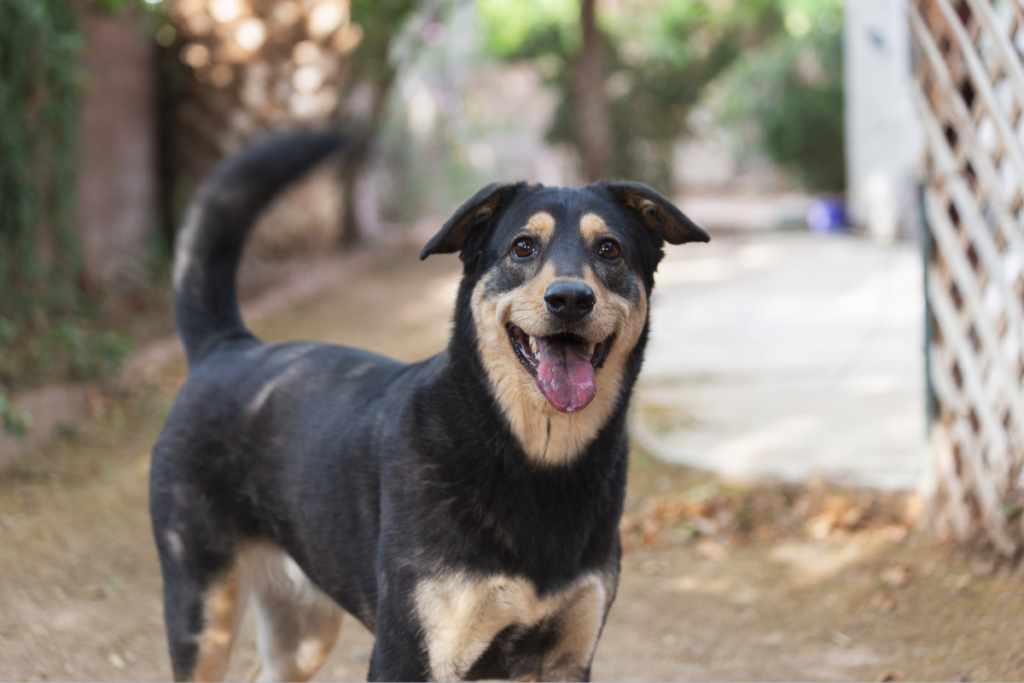How often do you wish your pet could talk to you and share exactly what they are thinking and feeling? At times it seems almost possible. Certain physical cues may seem clear cut, however dog communication is nuanced and complex. For example, most of us assume a wagging tail means a happy dog, but that’s not always the case. A dog uses its tail to convey a whole range of emotions — it is one of the most important tools a dog has to communicate with you and with other animals. As dog owners, we must learn how to read our dog’s body language to understand their responses and emotions in real time.
Table of contents:
- Why do dogs wag their tails?
- What does tail wagging mean?
- Interpreting a dog’s tail wag
- When to read the signs
- How can ElleVet’s CBD + CBDA help stressed dogs?
Why do dogs wag their tails?
A wagging tail is a canine trademark, something you probably see daily — during mealtimes, play times, and on your return home from work. According to psychologist Dr. Stanley Coren in Psychology Today, tail wagging is a form of language among dogs, one with its own specific vocabulary and grammar. There might be minor variations between breeds and individual temperaments, but the same general rules apply. This is not by chance but by design. “Dogs’ eyes are much more sensitive to movement than they are to details or colors, so a moving tail is very visible to other dogs,” writes Coren. “Evolution has made tails even more visible, such as tails with a light or dark tip, a lighter underside or a bushy shape.”
Modern dog breeds are all descendants of wild, wolf-like creatures that once lived in packs with complex hierarchies. As highly sociable animals, visible communication tools like the tail played an important function in daily life. Today’s dogs may have traded the pack for the human family, but they still employ the same strategy to connect and communicate with us through tail wagging.
Before learning to speak “tail,” first bear in mind the natural position of a dog’s tail, which can vary according to breed. The majority of dogs’ tails hang naturally to the ankle or “hock,” the major joint in a dog’s back leg. However, small dog breeds and brachycephalic breeds often have short tails that might curl tightly into a corkscrew, making it almost impossible to wag. Hounds and beagles often hold their tails in a straight position, while greyhound and whippet tails may hang between the legs and beneath the belly.
What does tail wagging mean?
Despite the commonly held belief that a waggy tail equals a happy pup, dogs will wag their tails to convey a range of emotions, including happiness, stress, defensiveness, submission, and excitement. Because of the range and variety of emotions, an understanding of the “language” of the tail can be very helpful. According to Dr. Coren, patterns of movement and tail position are the greatest indicators of how a dog is feeling.
Interpreting a dog’s tail wag
- Tail held at mid-height
When your dog holds their tail at a neutral, middle position with a steady wag, they are most likely feeling relaxed and content. The classic “happy wag,” this behavior is a familiar sight during a petting session or a calm walk.
- Tail held high
A tail held aloft and wagging with vigor is a sign your dog might be excited or interested in something — and is often coupled with pricked-up ears and an alert stance. This kind of tail talk might be observed when your dog sees its canine friends or notices something of interest, such as a toy or prey that it wants to chase. It indicates intense attention and excitement.
- Tail held stiffly upright
When a dog becomes threatened or highly anxious, the tail may reach its full upright position, held stiffy with a short tense wag. This body language indicates your dog’s defenses are up, as they are attempting to make themself appear bigger and more dominant to an opponent. Coupled with raised hackles and vocal expressions like a low growl, you should stay alert for sudden escalation or a fight/flight response.
- Tail held low
A low, cringing wag is your dog’s way of expressing nervousness or illness. This behavior communicates submission, meaning your dog is anxious or aiming to appease. You might notice low ears and head and darting, puppy-dog eyes.
- Tail between legs
As the tail lowers and becomes tucked between the legs in a low wag, your dog is expressing the most extreme form of fear and submission. This stance says “Please don’t hurt me.”
When to read the signs
In addition, context is very important. Is your dog at home with the family? A wagging tail is probably a sign of contentment. Is your dog in a new situation surrounded by unfamiliar people and animals? A wagging tail could be a sign of stress.
Anytime you bring your dog into a new situation or environment, or one that is known to provoke stress, keep an eye on your dog’s tail for a clue as to how it might behave. These physical cues might give you advance warning if your dog is about to become aggressive or prepare to flee.
- Veterinarian visits
- Kennel or boarding drop-offs
- Meeting unfamiliar dogs
- Meeting unfamiliar people
- During travel
- In an area with wild animals
- Around loud noises, such as fireworks displays
- Around young children (if not familiar with infants)
How can ElleVet’s CBD + CBDA help stressed dogs?
ElleVet’s CBD + CBDA chews, soft gels, and oils can offer support for your dog’s stress levels, helping relax and calm them. For dogs who might not need daily stress support but need maximum support in certain situations, ElleVet’s Calm and Comfort is perfect for situational use. For best results, give Calm and Comfort 1.5-2 hours before the trigger event. In addressing your dog’s stress, ElleVet’s CBD + CBDA can lead to improved overall well-being and a happier, less fearful dog.
Sources:









